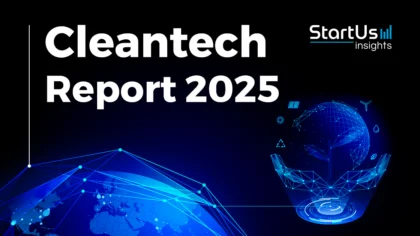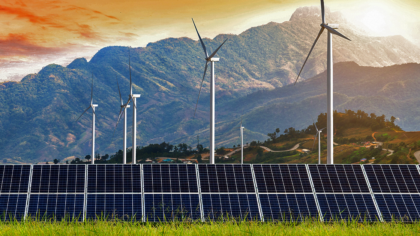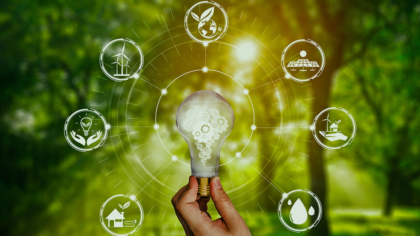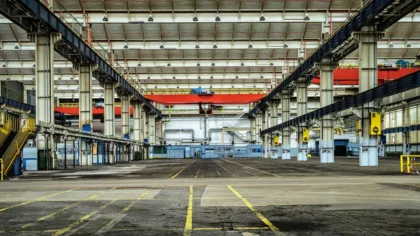Accelerate Productivity in 2025
Reignite Growth Despite the Global Slowdown
Climate change continues to dominate the global agenda, making large businesses reduce their carbon emissions and take a more proactive approach to emission management. This has led to a tech-driven approach that reduces the environmental impact of each product or service from the early stages of its development. At the same time, startups and scaleups develop technologies that reduce emission concentrations both at the source and in the atmosphere. These innovative technologies range from carbon offsetting and carbon capture technologies to bio-based solutions and emission monitoring. This data-driven research provides you with the top 10 global emission reduction technology trends in 2023 based on our research on 1680 startups and scaleups.
Innovation Map outlines the Top 10 Emission Reduction Technology Trends & 20 Promising Startups
For this in-depth research on the Top Emission Reduction Technology Trends & Startups, we analyzed a sample of 1680 global startups & scaleups. This data-driven research provides innovation intelligence that helps you improve strategic decision-making by giving you an overview of emerging technologies in the cleantech industry. In the Emission Reduction Technology Innovation Map, you get a comprehensive overview of the innovation trends & startups that impact your company.
These insights are derived by working with our Big Data & Artificial Intelligence-powered StartUs Insights Discovery Platform, covering 3 790 000+ startups & scaleups globally. As the world’s largest resource for data on emerging companies, the SaaS platform enables you to identify relevant technologies and industry trends quickly & exhaustively.
Tree Map reveals the Impact of the Top 10 Emission Reduction Technology Trends
Based on the Emission Reduction Technology Innovation Map, the Tree Map below illustrates the impact of the Top 10 Emission Reduction Technology Trends in 2023. Startups and scaleups are developing solutions that utilize artificial intelligence (AI), big data, and the internet of things (IoT). Such solutions monitor and analyze emission data and offer insights into abatement strategies. Advances in electrification, green hydrogen, and bio-based fuels and polymers aid the transition from fossil fuel-based energy sources to low or zero-carbon alternatives. Further, startups develop carbon capture, utilization, and storage (CCUS) technologies as well as waste valorization solutions. They reduce the emission concentrations both in the atmosphere and at the source. Additionally, energy-efficient integrations reduce the use of energy, improving emission reduction.
Top 10 Emission Reduction Technology Trends in 2023
- Carbon Offsetting
- Artificial Intelligence
- Electrification
- Green Hydrogen
- Carbon Capture, Utilization, & Storage
- Energy-Efficient Integrations
- Big Data
- Waste Valorization
- Bio-based Fuels & Polymers
- Emission Monitoring
Global Startup Heat Map covers 1680 Emission Reduction Technology Startups & Scaleups
The Global Startup Heat Map below highlights the global distribution of the 1680 exemplary startups & scaleups that we analyzed for this research. Created through the StartUs Insights Discovery Platform, the Heat Map reveals high startup activity in the UK and the US, followed by the rest of Western Europe. Below, you get to meet 20 out of these 1680 promising startups & scaleups as well as the solutions they develop. These emission reduction technology startups are hand-picked based on criteria such as founding year, location, funding raised, & more. Depending on your specific needs, your top picks might look entirely different.
Top 10 Emission Reduction Technology Trends
1. Carbon Offsetting
Carbon offsetting allows net-positive emitters to neutralize their greenhouse gas (GHG) emissions by trading negative carbon credits. The purchase of offset tokens facilitates the funding of initiatives that reduce carbon emissions, such as reforestation projects. Carbon-negative projects include technologies that capture GHG at industrial sites, improve soil management, and leverage energy-efficient integrations. This allows individuals, organizations, and governments to compensate for their polluting activities and mitigate them through the use of carbon credits. Further, cloud and blockchain-based bookkeeping improves the transparency of carbon credit records and makes them fully traceable. By offsetting emissions, individuals and organizations support projects that reduce or remove emissions from the atmosphere, mitigating the impact of climate change.
Abatable simplifies Carbon Intelligence & Procurement
UK-based startup Abatable offers a carbon intelligence and procurement platform. It aids the purchase of high-quality offsets for hard-to-abate emissions and maximizes the social impact of climate contributions. The platform provides insights into carbon projects and project developers by evaluating the fundamental factors contributing to the quality of carbon credits. Abatable continuously monitors every project to mitigate risks stemming from infrastructure, systems, and policies, ensuring the committed quality of carbon credits for organizations.
Tanso offers Automated Carbon Accounting
German startup Tanso automates carbon accounting and offers analytical solutions for effective emission reduction. The startup’s software simplifies data collection and emissions calculation through process automation, Excel/CSV uploads, application programming interface (API), and a single-source-of-truth approach. Tanso’s single-source-of-truth approach and automated processes provide organizations with their carbon footprint and set clear reduction goals. This allows the planning of decarbonization initiatives, like carbon offsetting and benchmarking, against science-based target standards.
2. Artificial Intelligence
AI allows organizations to collect and derive insights from massive amounts of data and identify patterns that humans fail or take time to recognize. Deeper insights into carbon emissions provide organizations with higher agility to adopt processes that cut down GHG emissions. This accelerates sustainable transformation and reduces expenses in a period of lower cash flow. AI-powered solutions also analyze the environmental impact of emissions and provide forecasts on storms, wildfires, and droughts, which enables better mitigation plans. Finally, AI aids the optimization of technologies related to carbon capture and renewable energy that improves efficiency and reduces emissions.
AI Shading ensures Low Building Carbon Footprint
AI Shading is a Canadian smart and green technology startup developing economical solutions that allow commercial buildings to achieve emission reduction targets. The startup’s solution also accomplishes this by regulating indoor temperatures through smart indoor shades, sensors, mobile apps, and energy management platforms. AI Shading equips building managers with energy-saving reports to better analyze energy usage and track emission reduction goals.
GAIA provides Automated Emission Tracking
Dutch startup GAIA leverages AI to simplify and automate GHG emissions reduction for businesses. The startup’s solution measures and tracks emissions by analyzing the data from the input of choice – manual, linked, or integrated. The AI algorithm utilizes the raw data to extrapolate measurements and approximate any missing data. This way, GAIA’s solution pinpoints main emission sources as well as customizes optimization roadmaps and emission reduction priorities.
3. Electrification
Electrification aids in emission reduction by replacing traditional fossil fuel-powered energy sources with clean, electric energy sources such as wind and solar power. This emission reduction technology trend finds application in multiple industries such as transportation, building, manufacturing, mining, and more. Besides the lower carbon intensity of clean electricity, energy efficiency is a key benefit of electrification as electric equipment is more efficient than its fossil-powered alternatives. Additionally, electrification enables demand flexibility to provide a cost-effective mechanism to share the available energy. Thus, the widespread adoption of electrification across various industries significantly reduces global emissions.
Zevx accelerates Fleet Electrification
US-based startup Zevx develops battery electric power systems and data intelligence for e-mobility applications. The startup’s powertrains and power system products accelerate the electrification of commercial fleet assets. Zevx’s data intelligence services further improve operational efficiency and enhance the control framework for power usage. The solution, in this way, provides an integrated platform that allows fleet owners to decarbonize all operational components.
Leaf Energy allows Seamless Energy Transition
US-based startup Leaf Energy offers electrification solutions like electric vehicles (EVs) and charging stations. The startup’s technology provides high-speed charging through its proprietary terminal designs that are compatible with existing grid networks. Leaf Energy also provides a platform that enables real-time environmental tracking, which allows businesses to measure progress at every step of the energy transition.
4. Green Hydrogen
Hydrogen fuel produced through the use of renewable energy in the electrolysis process emits no greenhouse gases and generates only water as a byproduct. The high calorific value and chemical properties of hydrogen offer utility across various industries, including transportation, heating, and industrial processes. In the transportation sector, green hydrogen fuel cells power vehicles, reducing emissions. It also serves as a key ingredient in the production of low-carbon chemicals and fuels, further decreasing emissions in these industries. As a clean energy source, green hydrogen reduces emissions and combats the effects of climate change.
Azolla generates Fuel-cell Spec Green Hydrogen
Canadian startup Azolla offers green hydrogen solutions for the power and transportation industries. The startup’s Biodrome technology utilizes a blend of bio-methanol and de-ionized water to generate fuel-cell spec hydrogen. The catalytic reformation of Azolla’s bio-methanol/water blend produces low-carbon hydrogen production on-site. This enables the use of methanol as a hydrogen carrier, which is easier to transport, store, and handle than high-pressure hydrogen or ammonia.
Faraday Fuels offers Solid Oxide Electrolyzers
US-based cleantech startup Faraday Fuels develops a scalable, high-throughput solid oxide technology to make green hydrogen. The startup’s solid oxide electrolyzers feature tubular design and proprietary electrodes to ensure efficient and low-cost production of clean hydrogen. This hydrogen serves as fuel to facilitate deep decarbonization of emission-intensive industries like steel, chemical, and aviation.
5. Carbon Capture, Utilization, & Storage
CCUS technologies capture carbon dioxide emissions and use them to make things or permanently store them thousands of feet below the surface. Startups utilize a range of technologies, some using membranes and others using solvents, to capture CO2. The captured carbon dioxide is then concentrated either chemically or in biological processes, which further serves as a feedstock or is simply stored underground. By preventing the CO2 from industrial operations from reaching the atmosphere, CCUS stabilizes CO2 levels. This provides carbon-neutral feedstock alternatives to industries like oil and gas, aviation, construction, and chemical. CO2 storage solutions, on the other hand, facilitate the use of depleted oil or gas fields or saline formations.
Algiecel advances Algal-based Carbon Capture
UK-based startup Algiecel develops modular photobioreactors that convert CO2 emissions and LED light into microalgae biomass and oxygen. The startup’s compact mobile microalgae photobioreactors and downstream units fit into standard shipping containers. This enables the transformation of industrial CO2 emissions into biomass rich in food-grade omega-3, proteins, vitamins, and carotenoids. The carbon capture solution in this way allows industrial plants to reduce their carbon emissions and enable a new revenue stream.
Aqualung achieves Absorbant-free Carbon Capture
Norwegian startup Aqualung develops an absorbent-free and highly compact membrane separation technology for carbon capture. The startup’s system utilizes less energy than conventional membranes by eliminating the regeneration energy associated with absorbents. It also avoids toxic additives or absorbents to lower operational risks and maintenance costs. Aqualung’s modular technology enables the deployment of carbon capture systems even for environments with low CO2 concentrations.

6. Energy-Efficient Integrations
Industrial excess energy is a largely untapped resource, for which there is potential for reuse as well as benefits industries and society. The utilization of excess energy in the form of heat, power, and fuel provides a way to reduce the use of primary energy. This contributes to the mitigation of CO2 emissions. The most common recovery solutions reuse discarded heat in secondary processes on site or use it to preheat incoming water and combustion air. Other power recovery solutions include the reclamation of pressure energy from processes operating at elevated pressures using even small pressure differences to produce electricity through pressure recovery turbines. In addition to solutions that recover wasted energy, innovations in materials and processes avoid energy wastage and cut down on the associated emissions.
Sapphire Technologies simplifies Excess Pressure Energy Recovery
US-based startup Sapphire Technologies creates energy recovery systems that harness the power of expanding gas to produce reliable and clean electricity. The startup’s FreeSpin In-line Turboexpander Generator specifically converts energy wasted in pressure reduction processes into electric power without interrupting operations. Sapphire Technologies’ solution caters to hydrogen and natural gas industrial applications. It maximizes efficiencies, improves productivity, reduces carbon emissions, offsets electrical costs, and achieves financial returns.
HT Materials Science facilitates Efficient Heat Transfer
Irish startup HT Material Science offers smart heat transfer fluids for commercial and industrial heating and cooling systems. The startup’s patented nanofluid additive, Maxwell, is a drop-in solution that enhances the heat transfer of a base refrigerant, improving the efficiency of HVAC systems. This reduces energy consumption and facilitates a proportional reduction in carbon emissions. The higher heat transfer rate enables the adoption of smaller, less costly, and more efficient equipment that further adds to operational sustainability.
7. Big Data
Big data allows businesses to identify areas of excessive energy consumption and carbon emissions, providing valuable information for efficient energy use energy and actions to curb emissions. Such solutions collate information from emission sensors and smart energy devices dotted across cities and facilities as well as historical operational data. Energy utilization data analysis allows businesses to identify patterns in energy use and improve energy efficiency. Big data solutions also aid supply chain optimization by analyzing transportation routes, inventory levels, and delivery times, reducing the distance traveled by goods and the resulting carbon footprint. Finally, by analyzing data on energy production and consumption, companies identify the best times to use renewable energy. This allows them to reduce reliance on non-renewable sources and, in turn, decrease their carbon footprint.
Grid Matrix aids Transport Emission Reduction
US-based startup Grid Matrix offers software that leverages existing traffic infrastructure to reduce congestion, emissions, and accidents. The startup’s cloud-based platform combines data from existing sensors and online sources to employ big data and analytics. It then provides real-time insights based on the collected data, facilitating the optimization of mobility services. This accelerates the transportation goals of cities and allows them to transition into safer, greener, and more efficient places to live and work. Consequently, this results in the elimination of congestion and greenhouse gas emissions.
CarbonSense simplifies Carbon Footprint Management
Chinese startup CarbonSense makes a software solution that allows businesses to achieve carbon neutrality. The startup’s green management system collects energy data from smart meters, water meters, gas sensors, temperature sensors, and equipment PLC as well as analyzes them through big data algorithms. The resultant insights include visualization of energy consumption, multi-dimensional energy consumption analysis, equipment efficiency analysis, and early warnings on equipment abnormalities. These insights enable intelligence decisions that minimize energy consumption and accelerate the adoption of renewable sources.
8. Waste Valorization
Waste valorization converts waste materials into useful products, upcycling end-of-life products and reducing carbon emissions. By diverting waste from landfills, it reduces methane emissions, which is a potent greenhouse gas that contributes significantly to climate change. Waste valorization also generates low-carbon energy in the form of biogas or biochar, which replaces fossil fuels and reduces GHG emissions associated with energy production. Recycling waste materials into new products further reduce the need for new materials and lower greenhouse gas emissions. Lastly, some waste valorization processes capture and utilize carbon dioxide emissions, mitigating their environmental impacts and advancing a circular carbon economy.
Alimentary advances Domestic Waste Valorization
New Zealand-based startup Alimentary designs and builds an integrated waste treatment plant (IWTP) that accepts all forms of organic waste. The startup’s patented waste treatment process combines biomimicry and anaerobic co-digestion, which is configurable to the local waste sources, to reduce waste disposal costs. It reduces all atmospheric greenhouse gas emissions related to household waste and wastewater treatment processes. In addition, the high-value biogas byproduct offsets costs by generating revenue.
Pyro-degrade facilitates Plastic Waste to Fuel Conversion
Kenyan startup Pyro-degrade develops a pyrolysis technology that converts plastic waste into fuel. Pyro-diesel is the startup’s fuel that serves as an environmentally friendly diesel substitute, which is free of sulfur and has a low carbon footprint. Moreover, the startup’s process is self-sufficient, enabling it to run off the grid with the fuel it produces. This technology avoids the open burning of plastic waste and provides a low-carbon diesel substitute for agricultural and other domestic applications.
9. Bio-based Fuels & Polymers
Bio-based solutions enable emission reduction by providing sustainable alternative energy sources and materials. Biofuels, such as bioethanol and biodiesel, are made from renewable plant-based materials and reduce the need for fossil fuels, resulting in fewer emissions. Biopolymers, such as biodegradable plastics, are sourced from natural fibers and resins that replace traditional petroleum-based plastics. Additionally, the production of biofuels and biopolymers often utilizes waste materials and by-products, reducing waste and emissions associated with waste management. By providing sustainable alternative energy sources and materials, biofuels, and biopolymers help to reduce emissions and contribute to a more sustainable future.
SeaH4 produces Carbon-Neutral Fuels
South African cleantech startup SeaH4 offers solutions that enable the profitable production of sustainable biodiesel and liquefied natural gas (LNG) from algae. The startup utilizes base technologies involving land-based algae farming, biogas production, gas processing, and gas-to-liquid conversion. SeeH4’s system is fully circular, minimizing operational expenditure and increasing yield. The final fuel product enables the CO2-neutral operation of combustion engines, accelerating the transition away from fossil fuels.
Dionymer offers Petrochemical Plastic Alternatives
French startup Dionymer develops material technology that upcycles industrial organic waste. The startup’s proprietary fermentation technology incorporates a biomimetic process that transforms organic waste into biodegradable polymer material polyhydroxyalkanoates (PHA). These polymer materials serve as low-carbon alternatives for petrochemical plastics. In addition to reducing carbon emissions, the technology provides a recovery path for bio-waste across industries like agriculture and pharmaceuticals.
10. Emission Monitoring
Emission monitoring and management reduce emissions by enabling organizations to accurately measure and track their emissions and identify opportunities for reduction. Monitoring systems detect emissions from various sources and provide real-time data on emissions levels. Management systems then analyze and interpret this data, allowing organizations to identify improvement areas and implement emission reduction strategies. By regularly monitoring and managing emissions, organizations ensure their emissions are within legal limits, reduce their environmental impact, and improve their sustainability. Moreover, organizations now leverage a comprehensive and systematic approach to emission reduction, monitoring, and management. This helps them to achieve emission reduction goals and ensure carbon-neutral operations.
GAIT delivers Greenhouse Gas Measurement
Singaporean startup GAIT offers climate tech solutions that facilitate the deployment of GHG measurement systems. The startup’s technology combines machine learning, flux sensors, and spatial data to deliver real-time measurements of greenhouse gas emissions. Additionally, it accesses historical flux data to provide more accurate models that measure the effectiveness of climate action projects. The solution also provides recommendations on actions required to further reduce emissions and achieve the set air quality targets.
Blue Sky advances Fugitive Methane Emission Detection
Blue Sky is a US-based startup that develops an infrared optical sensor technology for the continuous detection and measurement of fugitive methane emissions. NIRview is the startup’s emission monitoring solution that employs a spectroscopy-based approach to automatically scan a user-defined grid and provide a detailed 2D concentration map. The solution in this way offers oilfields a cost-effective detection technology that pinpoints the location of leaks, facilitating quick repairs and substantially reducing emissions.
Discover all Emission Reduction Technology Trends, Technologies & Startups
Advances in emissions reduction technologies continue to advance as the demand for a net zero existence becomes critical. Carbon offsetting serves as a crucial method in ensuring the financial sustainability of carbon reduction projects and initiatives. Innovations in emission monitoring and reporting through the integration of technologies, like blockchain and IoT, ensure transparency across supply chains. This facilitates close monitoring of emission reduction efforts and allows businesses to properly channel resources for achieving emission goals. The Emission Reduction Technology Trends & Startups outlined in this report only scratch the surface of trends that we identified during our data-driven innovation & startup scouting process. Identifying new opportunities & emerging technologies to implement into your business goes a long way in gaining a competitive advantage.
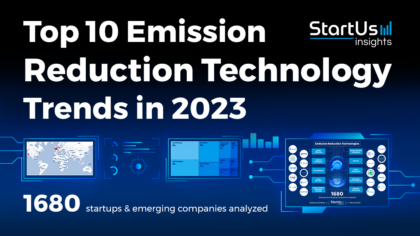
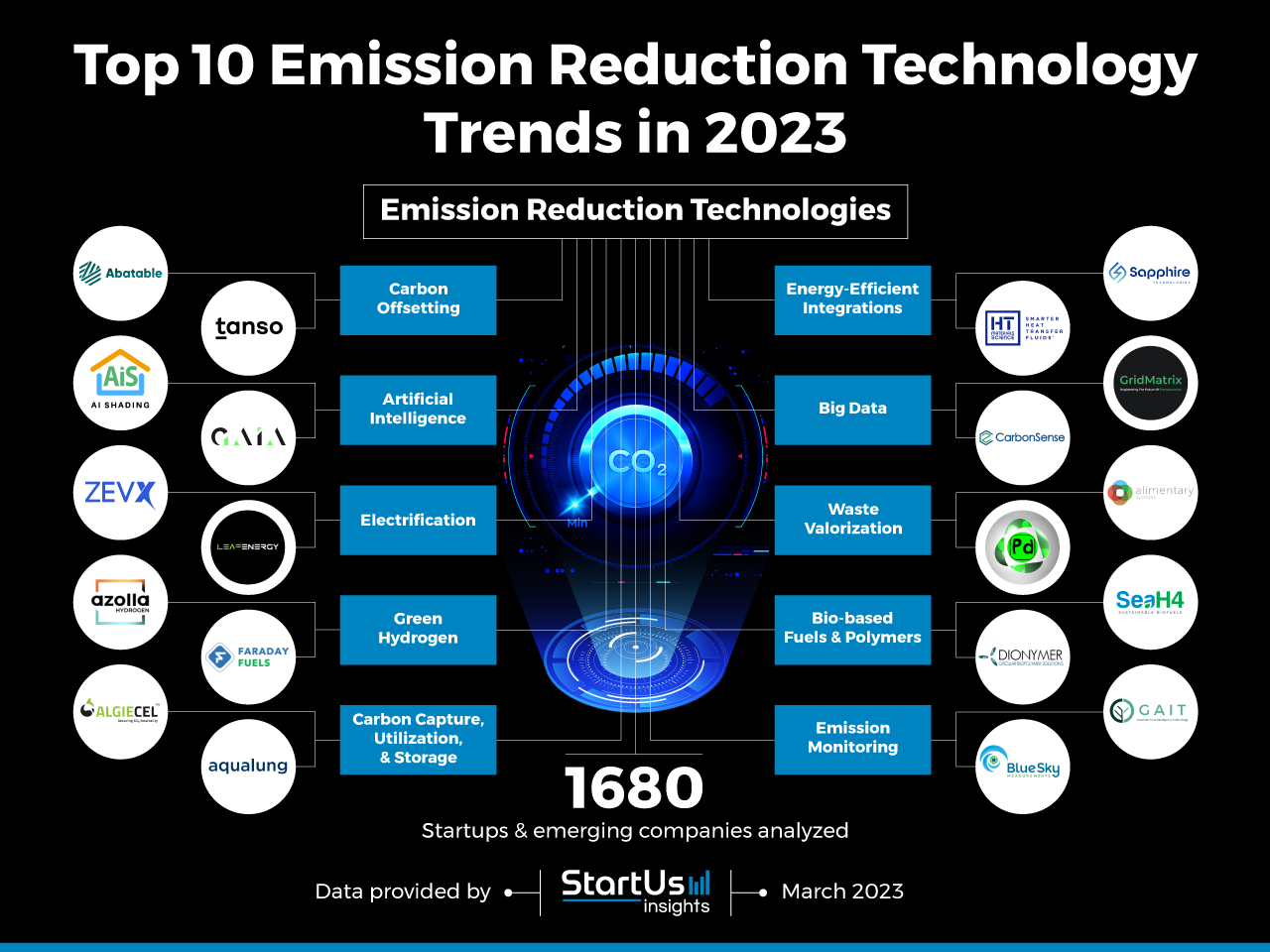
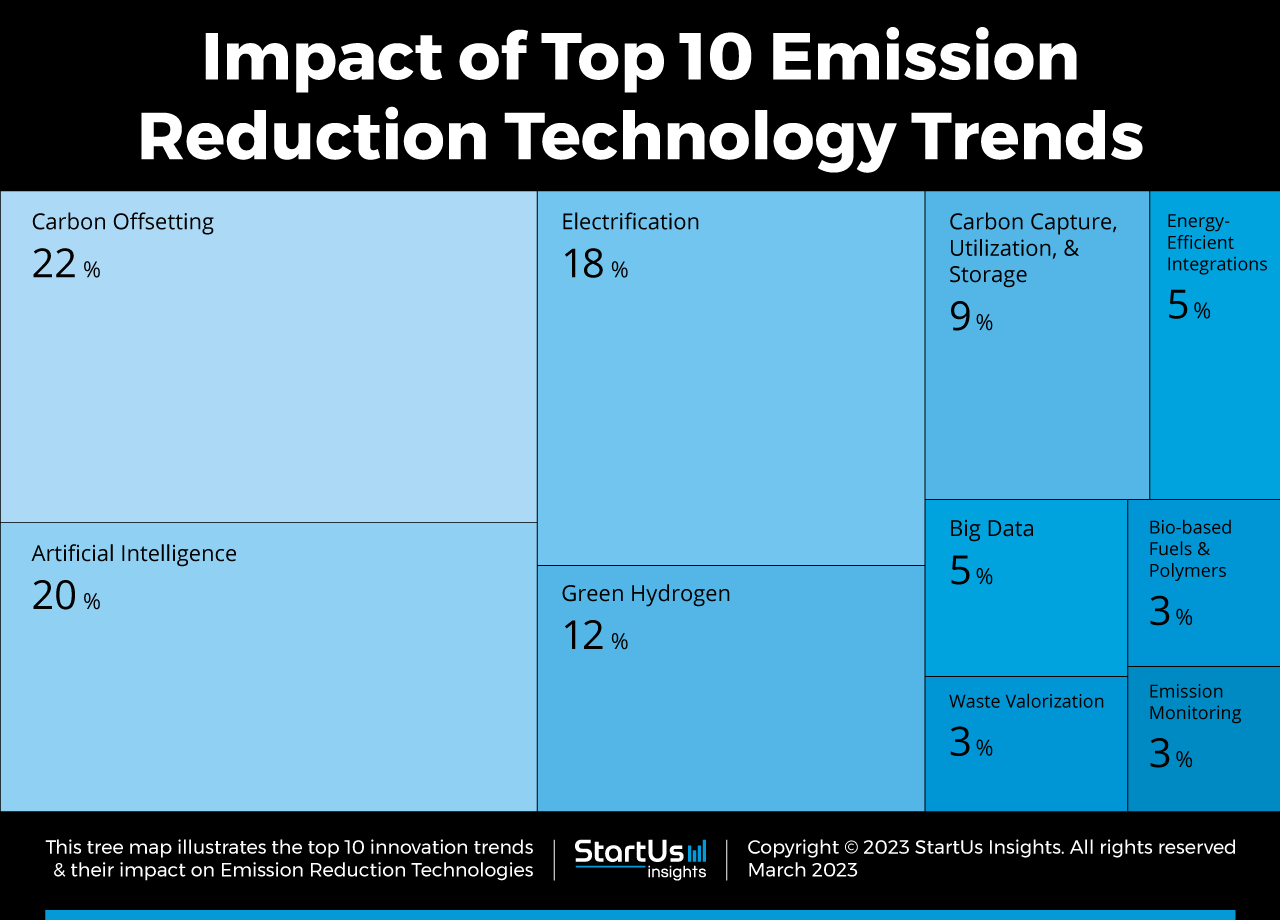
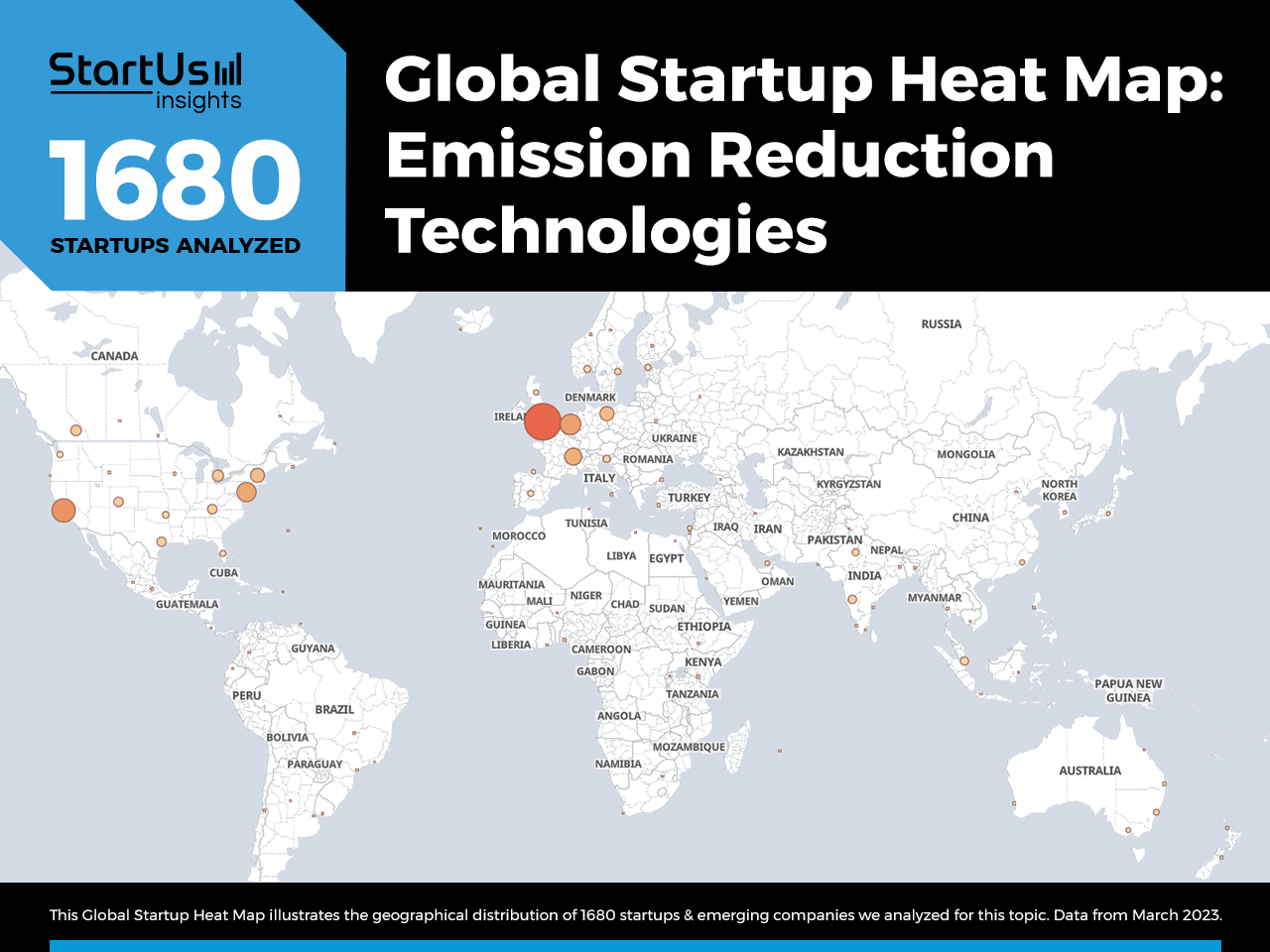

![Explore the Top 10 Waste Management Industry Trends & Innovations [2025]](https://www.startus-insights.com/wp-content/uploads/2025/06/Waste-Management-Industry-Trends-SharedImg-StartUs-Insights-noresize-420x236.webp)
